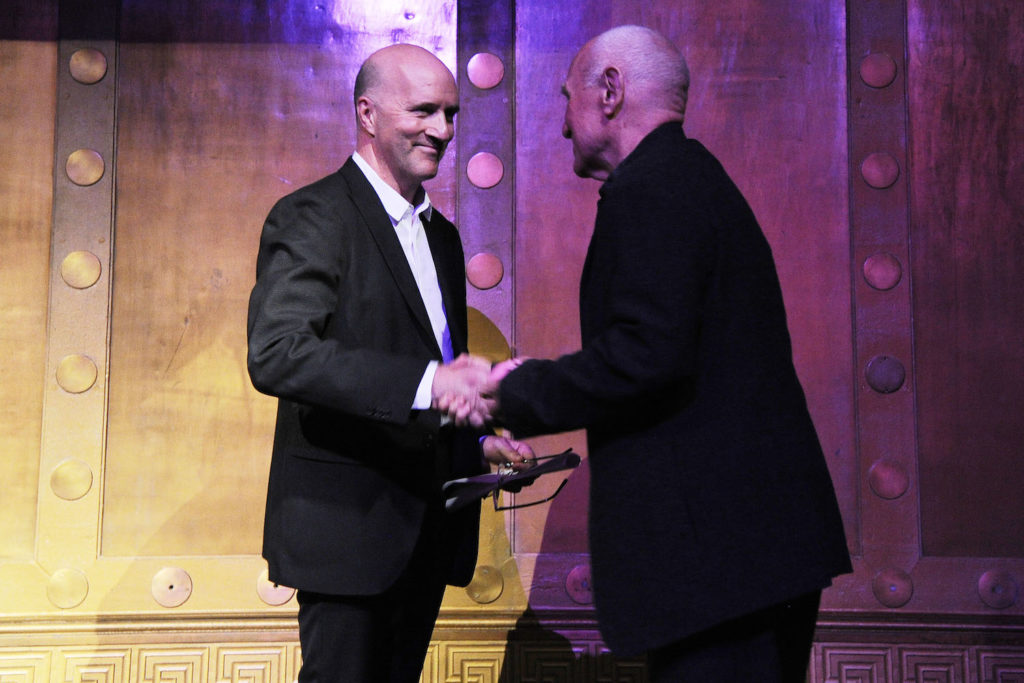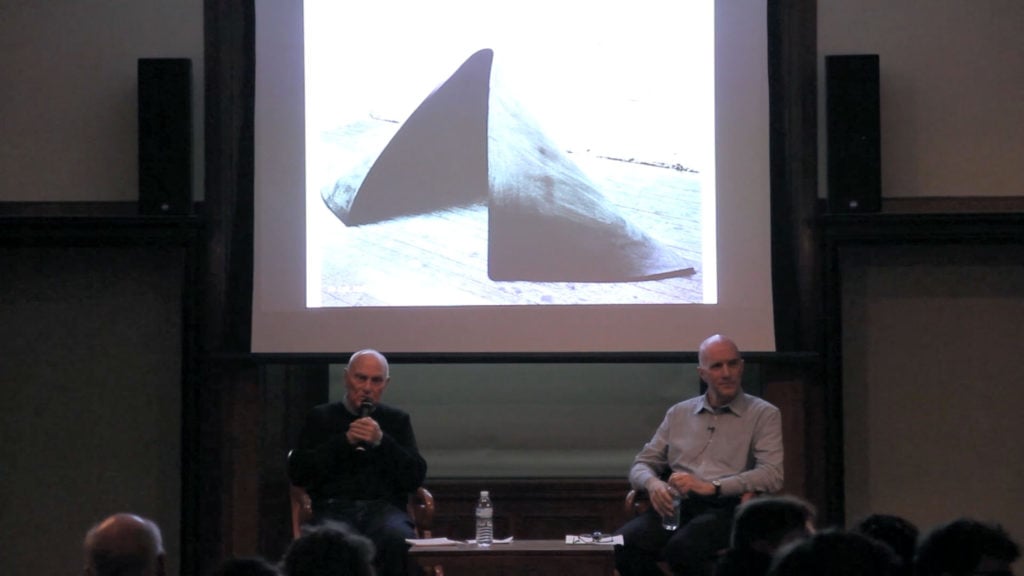The following interview is from Conversations About Sculpture, a collection of dialogues between the artist Richard Serra and the author and critic Hal Foster, held over the course of 15 years. The excerpt comes from the section on Serra’s formative period as a student at Yale and his time studying in France.
Hal Foster: How did you negotiate the figures who visited Yale, with all their different materials, mediums, and protocols in the studio? Apart from Albers, you had Rauschenberg, Johns, and Stella as well as Guston and Reinhardt.
Richard Serra: Reinhardt was very influential. He gave university-wide lectures, not just to art and architecture students. His “Twelve Rules for a New Academy” (1953) and his manifestoes were impressive, especially the way he approached a position through negation. But you had to digest all the visitors as best you could. Also, twice a day at Yale I passed Mondrian’s Foxtrot; Duchamp’s Tu m’ was upstairs, and Brancusi’s Yellow Bird was in the hall.
We were in school not to break ground but to work our way from Cézanne to Pollock, de Kooning, or Johns. That’s what students did at the time. Some imitated the New York scene immediately in front of them, but if that was all you were doing, you were already rearguard, and everybody knew it. I ended up painting knock-off Pollock–de Koonings.
Was Russian Constructivism in the mix for you then? Camilla Gray’s book, The Great Experiment: Russian Art 1863–1922, was published in 1962, and it was immediately important for Carl Andre, Sol LeWitt, and Flavin.
I wasn’t interested in Constructivism at the time. I was a painter, trying to figure out what that meant, and whether I wanted to continue painting. Yale awards a traveling fellowship; I was fortunate enough to get one, so I had a year in Europe. I went to Paris, and that changed my whole grounding.
Why? I know you went to the Cinemathèque Française regularly, and that the Brancusi studio was important to you, but how did Paris change your entire orientation?
I hadn’t looked at much sculpture before. I was going to the Académie de la Grande Chaumière to draw every day, but that seemed, well, academic. I saw as many shows as I could; the big ones involved well-established artists: Magritte, Francis Bacon, Giacometti, artists of that generation. They were mythical figures, empowering, but there was no new scene in Paris.
Ileanna Sonnabend had a gallery that showed Edward Higgins and Lee Bontecou, yet Rauschenberg wasn’t there. In fact, the American scene hadn’t entered Paris much, and the abstract scene—the École de Paris with artists like Hans Hartung—was boring. I found my way to Brancusi’s reconstructed studio in the Musée National d’Art Moderne, and I began to draw. I can’t tell you why, but something just clicked. Drawing has a lot to do with how a volume hits an edge, how it cuts into space, and it was enormously helpful for me to work there. Maybe the studio had an aura that attracted me too; maybe it smelled like art.
Did Brancusi equal sculpture for you then? Or did you see a tradition—before him, after him—that you could draw on?
No. I knew very little about Brancusi, very little about sculpture. But if you’re young and want a foothold in sculpture—whether to go into figuration and content or into abstraction and space—Brancusi is an encyclopedia. He’s very pure, authoritative, convincing.
There was the New Wave in Paris, and I was going to the Cinemathèque to see Truffaut, Godard, Resnais, and Bresson. I was aware that I was watching a new idiom in the making. By comparison the French painting scene wasn’t interesting, with the exception of the artist who painted under the influence of mescaline…
Henri Michaux.
Yes, I saw a show of his and never forgot it; it was one of the most interesting events in my year in Paris. I had a fairly good sense of Pollock by then, and that show—in terms of marking a field—suggested a similar nonanalytical way out. It certainly had nothing to do with Brancusi: He was about a reduction to form, volume, shape. Michaux, like Pollock, opened up the field.
Nonanalytical as in not fully calculated? No apparent intention that preceded the actual marks?
Yes, there was nothing prescribed about it, and that interested me. I had done mescaline in Santa Barbara, but I didn’t understand how anyone could make art in that state. In my last year in college I had read Michel Butor as well as Camus. Butor’s spareness of language influenced me: the clarity in his descriptions and his concrete relation to experience. Later I discovered that Roland Barthes had the same clarity of language. Again, between Santa Barbara, Yale, and Paris a lot was coming at me: Camus, Michaux, Brancusi, film… I didn’t know how all those things would come together.

Hal Foster and Richard Serra at BOMB Magazine’s Gala, April 30, 2012. © PatrickMcMullan. Photo courtesy Nicholas Hunt/PMC.
The work you began to do then—objects, assemblages…
That was the next year, in 1966, when I went to Florence on a Fulbright. I had read John Cage’s Silence (1961); Phil Glass and I read it to each other in Paris. Cage collaged his lectures from different conventions and disciplines, and he did it in a very roll-the-dice way. With its antecedents in Dada, it was too much like unrestrained poetry, and that didn’t interest me. I was involved in language, with its specificity—whether in Americans like Faulkner or Steinbeck, or Russians like Dostoevsky, Pushkin, or Gogol, or the French like Stendhal, Camus, or Butor—and Cage’s permissive poetry didn’t have enough structure for me.
It was a dead end for you—unlike for many in the generation ahead of you in New York.
Yes. In Florence I started painting grids with arbitrary colors, covering each square in a minute or so. Then I went to the American library, saw a recent issue of Artnews that included a grid painting by Kelly with random colors, and it looked like what I had just done.
I thought if Cage was going to lead me to become a formalist Kelly, I couldn’t go on, so I dropped Cage as well as Kelly. Then I made a trip to Spain, and seeing Velázquez was very important. That ended it for me.
Las Meninas in particular? Ended what exactly? There seemed to be nothing left to do with the fundamental problems of painting?
I realized there was a split between the interior illusion of space and the projected space I was standing in, and that I was the subject of the painting and Velázquez was looking at me. That really bothered me—that I was the subject of the painting—because I didn’t think I could make a painting in which the viewer was its subject. I wasn’t interested in mirrors. I knew what the Dutch had done, and Velázquez had done it better. I was flabbergasted.
Why? You make sculpture whose subject is the viewer—why not painting? It’s interesting that your encounter with Las Meninas occurred just about when Foucault took it up as the paragon of classical representation in The Order of Things (1966). And he says much the same thing—that the painting makes the viewer its subject.
Las Meninas made me see that my way of dealing with painting was limited to looking at something inside a frame. Living in Florence, I had come to love the Florentine painters—Fra Angelico, Uccello, all of them. But I thought, “Jesus, I’m up to the same thing. I might as well be looking out the window. All I’m doing is looking at painting inside a frame.” It’s then that I decided to make cages, to stuff them with material, to use live animals, to do anything to get away from my education, from all of it.
To get away from pictorial space?
Yes. In the Museo della Specola in Florence there are stuffed cadavers by Clemente Susini made of wax, slit from scrotum to throat, and opened up so you can see the splayed intestines. They’re extraordinarily beautiful and also perverse and sexual. Nancy Graves and I (we were together then) used to go look at them. At the same time I became interested in zoos (Florence had the first zoos). So I got the idea of stuffing animals and presenting assemblages, and I used cages, stacking them one on top of the other à la Brancusi. Again, I wanted to do something I wasn’t taught or had seen before, something that dealt with different materials. I took stuff from junk shops, thrift stores, and off the street, just threw it together, and tried to make some metaphor out of what was stuffed and what was alive, illusion and reality. It was barnyard-assemblage-Surrealism, very much student work.

Richard Serra and Hal Foster at “Early Work: Richard Serra, Hal Foster,” an Art Book Series Event at New York Public Library, April 30, 2014. Projected image: Serra’s To Lift (1967). Courtesy the artist and David Zwirner.
Was there any sense of the beginnings of Arte Povera then?
When I went to Rome I had a show that caused an enormous uproar.
This is still 1966?
Yes. The police closed down the show because of the live animals, so we got an injunction to reopen it. All the people from the Tartaruga gallery came to see it (Tartaruga exhibited Cy Twombly and Piero Manzoni, as well as Jannis Kounellis and others who would later form Arte Povera). A lot of things were in the air: Rauschenberg, Lucas Samaras, Ed Kienholz, many others dealing with assemblage. Three years later Kounellis lined up his twelve horses in that gallery. So my work was inadvertently connected to Arte Povera.
But you didn’t elaborate on that line of work.
I didn’t know what it was. We were isolated. We thought we were up to no good, but we didn’t know whether no good was good, or whether anyone would be interested.
***
Conversations About Sculpture will be published by Yale University Press in November.








